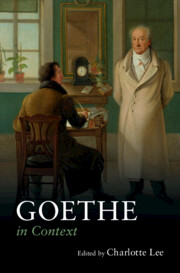Book contents
- Goethe in Context
- Goethe in Context
- Copyright page
- Contents
- Illustrations
- Notes on Contributors
- Acknowledgements
- Note on Translations and List of Abbreviations
- Chronology
- Introduction
- Part I Life and Times
- Part II Literature
- Part III Art
- Part IV Philosophy and Science
- Chapter 19 Goethe and Philosophy
- Chapter 20 Goethe’s Improper Mode of Thought
- Chapter 21 Goethe and German Idealism
- Chapter 22 Morphology
- Chapter 23 Colour Theory
- Chapter 24 Geology
- Part V World Cultures Inspiration and Reception
- Part VI Goethe’s Lasting Significance
- Further Reading
- Index
Chapter 20 - Goethe’s Improper Mode of Thought
from Part IV - Philosophy and Science
Published online by Cambridge University Press: 16 May 2024
- Goethe in Context
- Goethe in Context
- Copyright page
- Contents
- Illustrations
- Notes on Contributors
- Acknowledgements
- Note on Translations and List of Abbreviations
- Chronology
- Introduction
- Part I Life and Times
- Part II Literature
- Part III Art
- Part IV Philosophy and Science
- Chapter 19 Goethe and Philosophy
- Chapter 20 Goethe’s Improper Mode of Thought
- Chapter 21 Goethe and German Idealism
- Chapter 22 Morphology
- Chapter 23 Colour Theory
- Chapter 24 Geology
- Part V World Cultures Inspiration and Reception
- Part VI Goethe’s Lasting Significance
- Further Reading
- Index
Summary
Chapter 20 reflects on Goethe’s unique way of thinking and his persistent challenges to orthodoxy. It builds on Goethe’s own assertion that he was ‘not naturally equipped to do philosophy in its proper sense’, and argues that his thought engages the figurative power of ‘improper’ (that is, poetic) language to do philosophical work. The chapter notes his criticism of the modes of, among others, Kant and Hegel, and highlights places in Goethe’s oeuvre, including in his literary works, where we can see new and unconventional pathways for thought being built.
- Type
- Chapter
- Information
- Goethe in Context , pp. 196 - 205Publisher: Cambridge University PressPrint publication year: 2024

